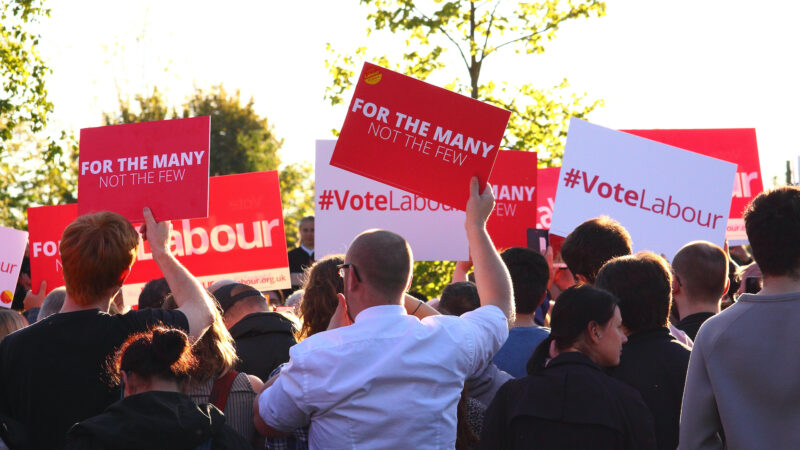
Keir Starmer’s leadership election success compared to past contests.
Keir Starmer won the Labour leadership with 56.2% of the total votes cast by members, affiliates and registered supporters.
This is less than Jeremy Corbyn on a percentage basis. The former Labour leader secured 59.5% in 2015 against three rivals and 61.8% in 2016 against one challenger.
But Starmer won a bigger number of votes – 275,780 – than Corbyn did in 2015, when he won 251,417 against three hopefuls. The following year Corbyn received 313,219 votes against Owen Smith.
Click here for our full analysis.
Lisa Nandy came second in affiliate and registered supporters sections.
Keir Starmer won with 56.2% on the first round, as we’ve established, while Rebecca Long-Bailey came second with 27.6% and Lisa Nandy third with 16.2%. These totals are the combination of all votes – from members, affiliates and registered supporters.
But looking at the results by section, it is clear that Long-Bailey was a little more popular among members than the selectorate as a whole. In this section, she got 29.3%. Starmer 56.1% – practically the same – and Nandy a little lower on 14.6%.
Where Nandy did far better was among registered supporters and affiliates – i.e. members of trade unions and affiliated groups such as the Fabians who signed up to vote in the election. The Wigan MP placed second, ahead of Long-Bailey.
It comes as little surprise that Long-Bailey secured just 5% of registered supporters – Corbynite levels in Labour’s membership were ‘maxed out’, and these people likely registered to back Starmer or Nandy, or initially signed up to vote for Jess Phillips.
Dawn Butler placed last in Labour’s deputy leadership race.
The Brent MP is passionate and charismatic – she could always be relied upon to liven up hustings during the campaign, usually with a rendition of ‘Something Inside So Strong’. She also has better name recognition than other deputy candidates, and was expected to place at least fourth.
But Butler did not secure the GMB nomination, despite having been a GMB organiser before entering parliament. She made her disappointment about this decision pretty clear during the campaign.
She also refused to sign the Board of Deputies’ pledges on the basis that the party needed to act on the EHRC recommendations first. This lost her some support, leaving many Jewish Labour Movement members feeling let down, and she was never going to out-Burgon Burgon.
Rosena Allin-Khan came second in the deputy leadership contest.
It is testament to a strong campaign by Allin-Khan that the Tooting MP placed second – ahead of Richard Burgon, who was expected to be the runner-up to Angela Rayner.
Allin-Khan had little familiarity among members at the start of the race, as reflected in her local party nominations – she secured 56, compared to Burgon’s 77, Butler’s 82 and Murray’s 60.
Yet she managed to exude warmth and positivity during the campaign, and sent strong messages on antisemitism and LGBT rights. This won her crucial support.
Lauren Townsend and Matt Kerr were the most successful Labour left candidates.
Out of all Labour’s internal elections this week, the Labour for a Green New Deal/CWU activist and the left-wing Glasgow councillor were the two most triumphant, though neither won.
Momentum-backed Townsend came third in the by-elections for two local party representatives on the national executive committee (NEC). She was just 252 votes behind Corbynsceptic-endorsed Johanna Baxter, and could have won if the Labour left had put together a single slate for the contest.
Momentum-aligned Kerr secured 7,528 votes out of 17,839 in the Scottish Labour deputy leadership race – i.e. 42%. He only had one rival, the successful Corbynsceptic candidate Jackie Baillie, so it wasn’t exactly narrow. But it was a lot better than Long-Bailey’s 27.6%.
The NEC is now much better suited to Starmer.
Labour’s NEC had a significant left majority under Corbyn, but Corbynites frequently complained that it was ‘soft’ and ‘narrow’. It’s always complicated to determine the left-right balance on the NEC.
On top of three new reps who were all backed by Progress and Labour First, Starmer will be able to appoint three frontbenchers. Plus he and the deputy have changed. That is eight new NEC members in total that will largely be helpful to Starmer’s plans.
I would say that this makes the NEC now approximately 18-19 for the left, but again this is very soft and based on members’ current behaviour rather than how they might change under Starmer. Which way votes go will really depend on the issue in question and whether the new leader can persuade waverers.



More from LabourList
Humza Yousaf woes deepen as Labour plans no-confidence vote in government
‘History and poll leads suggest Labour can be bolder, even if it costs some votes’
Labour warned ‘ethical foreign policy’ inevitably sparks charge of ‘hypocrisy’